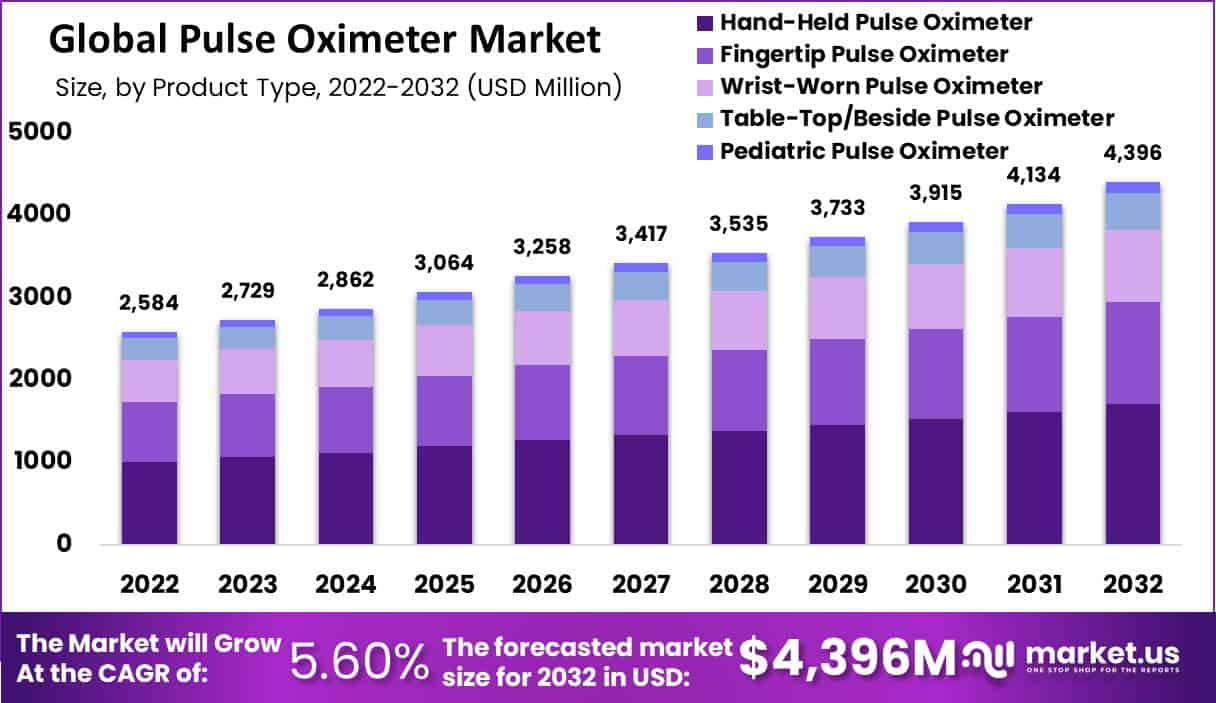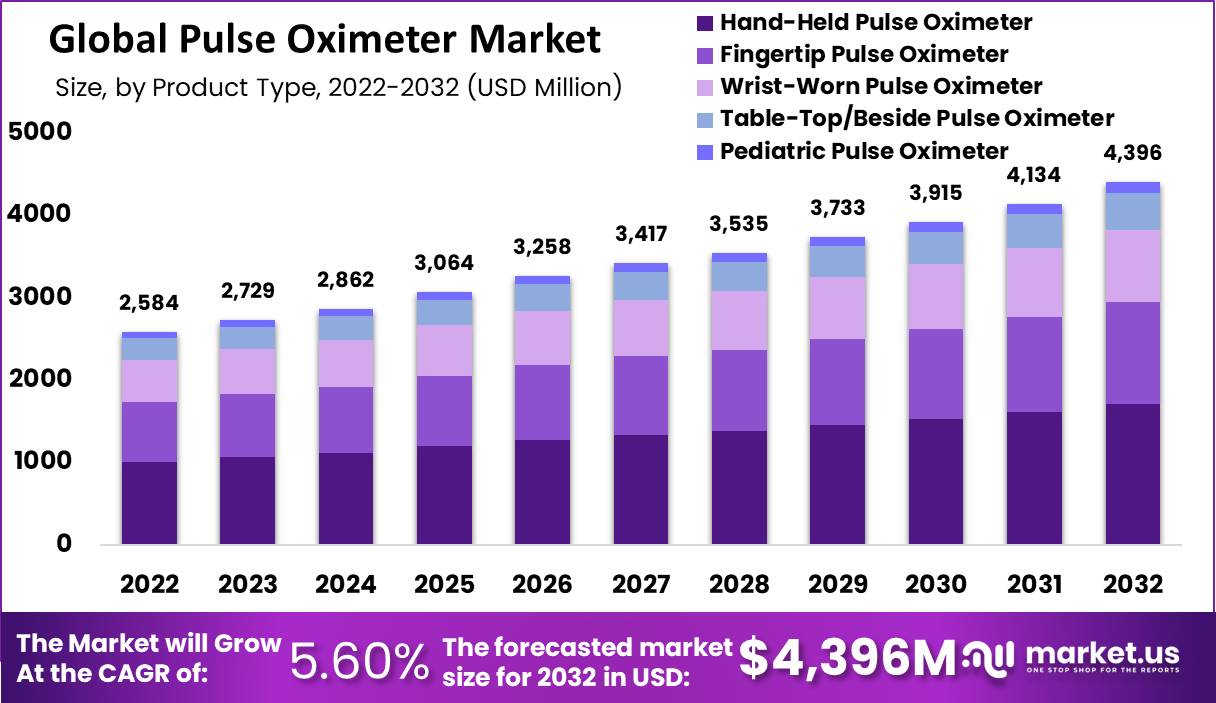Pulse Oximeter Market Anticipates Growth with Emphasis on Real-Time Health Monitoring

The global pulse oximeter market is projected to reach USD 4,396 million by 2032, growing from USD 2,729 million in 2023 at a CAGR of 5.6% during the forecast period. This growth is mainly driven by the rising burden of respiratory conditions worldwide. According to the World Health Organization (WHO), chronic respiratory diseases like asthma and chronic obstructive pulmonary disease (COPD) are increasing rapidly. These conditions often require regular oxygen level checks. Pulse oximeters offer a non-invasive, simple method to monitor oxygen saturation, making them highly valuable for both clinical and home use.
Another key factor boosting the market is the growing awareness of personal health. During the COVID-19 pandemic, pulse oximeters gained attention as essential monitoring tools. Health agencies such as the Centers for Disease Control and Prevention (CDC) encouraged their use for tracking oxygen levels during respiratory infections. As a result, public understanding of these devices improved significantly. Even after the pandemic, people are continuing to use them to manage conditions like long COVID and other respiratory illnesses, which helps maintain strong market demand.
Technology is playing a major role in shaping the pulse oximeter market. Many modern devices now include Bluetooth or mobile app integration, allowing users to track their oxygen levels and heart rates over time. These innovations appeal to both healthcare professionals and everyday consumers. The National Institutes of Health (NIH) and other public health institutions have also supported improvements in device accuracy and accessibility, helping to advance product quality across the market.
Finally, the trend toward wearable and portable health devices is accelerating. Fitness bands and smartwatches with built-in pulse oximeters are becoming more popular, especially among tech-savvy and younger users. These tools support general wellness monitoring and preventive healthcare. As consumers focus more on fitness and long-term health, demand for compact and convenient monitoring tools continues to grow. Altogether, these factors strongly support the rising adoption of pulse oximeters across both clinical and personal settings.

Key Takeaways
- The global pulse oximeter market is projected to reach USD 4,396 million by 2032, growing from USD 2,729 million in 2023.
- This market is expanding at a steady CAGR of 5.6% between 2023 and 2032, reflecting rising demand for non-invasive monitoring tools.
- North America holds the dominant position, accounting for approximately 45% of the global pulse oximeter market share due to strong healthcare infrastructure.
- Europe ranks as the second-largest market, driven by increasing healthcare spending and growing awareness about patient monitoring devices.
- Key companies in this space include GE Healthcare, Philips, Masimo, Medtronic, Nonin, Nihon Kohden, and CareFusion, among several others.
- These devices are commonly used by healthcare professionals in hospitals and emergency rooms to monitor blood oxygen saturation and heart rate levels.
- In 2022, hand-held pulse oximeters made up 38.9% of the global market, owing to their portability and ease of use in clinical settings.
- Devices using conventional technology were the most popular in 2022, preferred for their reliability and widespread availability in hospitals and clinics.
- Pediatrics emerged as the largest age group using pulse oximeters in 2022, highlighting the growing concern for child respiratory health.
- Hospitals and clinics represented about 80% of total pulse oximeter usage in 2022, reflecting institutional dependence on continuous patient monitoring.
GET SAMPLE REPORT : https://market.us/report/pulse-oximeter-market/free-sample/
Emerging Trends
1. Growing Use of Pulse Oximeters at Home
More people are now using pulse oximeters at home. This trend became popular during the COVID-19 pandemic. People needed to check their oxygen levels without visiting a hospital. Even after the pandemic, the trend continues. Those with asthma, COPD, or heart problems still use these devices at home. It helps them keep track of their health regularly. Home monitoring tools are easy to use and save time. This has increased their demand in the market. The home-use trend is likely to grow as people become more health-conscious. It also reduces the pressure on hospitals and clinics.
2. Integration with Smartphones and Health Apps
Today’s pulse oximeters are smarter than ever. Many new models connect to smartphones via Bluetooth. This allows users to record their oxygen levels and heart rate in real time. Health apps help users track changes over weeks or months. They can also share data directly with doctors. This is useful for ongoing health checkups. These smart features make the devices more user-friendly. The ease of use is attracting more buyers. This trend is leading to more connected and digital healthcare solutions. It supports preventive care and better health management.
3. Rising Focus on Remote Patient Monitoring (RPM)
Healthcare providers are using more remote monitoring systems. Pulse oximeters are an important part of these systems. They are especially useful for patients recovering from surgery or illnesses like COVID-19. RPM allows doctors to check patients without in-person visits. It reduces hospital stays and improves care. This also lowers healthcare costs in the long run. Portable and wireless pulse oximeters are in high demand. These tools help keep patients safe at home. As telehealth services expand, this trend will likely grow stronger in the coming years.
4. Use in Fitness and Wellness Devices
Pulse oximeters are now part of many fitness gadgets. Smartwatches and fitness bands often include SpO₂ monitoring. These features are not always medical-grade, but they are popular. Health-conscious people use them during workouts or sleep tracking. These wearables give quick updates on oxygen levels. The demand is rising as more people want to monitor their overall wellness. Brands are adding these features to attract fitness users. As awareness of oxygen levels grows, more consumers prefer gadgets that include pulse oximeters.
5. Demand in Developing Countries
There is a growing need for affordable pulse oximeters in developing regions. Many rural and remote areas lack access to hospitals. These devices help people monitor their oxygen levels easily. Governments and NGOs are stepping in to support this effort. They are working to distribute these tools widely. In many low- and middle-income countries, pulse oximeters are becoming essential. They are especially helpful in managing diseases like pneumonia and COVID-19. This trend is creating new market opportunities. It also highlights the need for simple, low-cost medical solutions.
Conclusion
In conclusion, the pulse oximeter market is steadily growing due to rising awareness of personal health and the increasing need for reliable oxygen monitoring tools. These devices are becoming more common in both hospitals and homes, especially as people manage long-term respiratory conditions. Advancements in technology, such as smartphone integration and wearable features, are making pulse oximeters more convenient and appealing. There is also growing demand in developing regions where access to healthcare is limited. As the focus on preventive care and remote monitoring continues, pulse oximeters are expected to remain an important part of modern healthcare solutions. This makes the market promising for future growth and innovation.
- Art
- Causes
- Crafts
- Dance
- Drinks
- Film
- Fitness
- Food
- Spellen
- Gardening
- Health
- Home
- Literature
- Music
- Networking
- Other
- Party
- Religion
- Shopping
- Sports
- Theater
- Wellness


